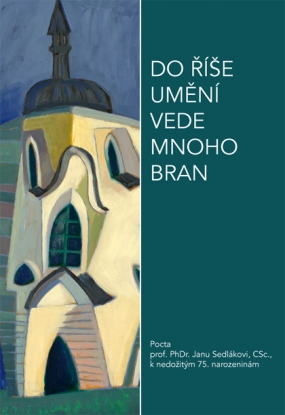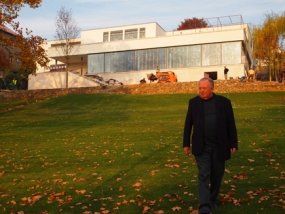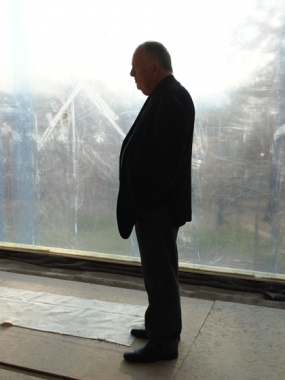In honour of Professor Jan Sedlák on what would have been his 75th birthday
At the end of 2018, VUTIUM, the publishing house of the Brno University of Technology, produced a book dedicated to Jan Sedlák, in cooperation with the National Monument Institute branch in Brno and the Brno City Museum.
Brno Art historian and university professor Jan Sedlák, who would have been 75 last year, is the author of numerous professional publications and essays, especially on Art Nouveau and modernist architecture. He is also the author of one of the monographs on Villa Tugendhat, titled "The Tugendhat Villa, A Space for Art and Spirit," released in 2012.
Editors and co-authors of the book, Dagmar Černoušková and Jindřich Chatrný, hail from the Architecture History Department of the Brno City Museum. More than six dozen of Czech and foreign authors, mostly art historians and architects, contributed to the publication, among them, for example, Pavel Borský, Pavla Cenková, Iveta Černá, Matúš Dulla, Hana Dvořáková, Petr Fidler, Aleš Filip, Milena Flodrová, Ladislava Horňáková, Martina Hrabová, Petr Hrůša, Andrea Husseiniová, Lukáš Kos, Dagmar Koudelková, Markus Kristan, Jiří Kroupa, Martina Lehmannová, Christopher Long, Otakar Máčel, Zoja Matulíková, Iris Meder, Henrieta Moravčíková, Josef Němec, Damjan Prelovšek, Ivan Ruller, Tomáš Rusín, Lubomír Slavíček, Miloš Stehlík, Markéta Svobodová, Maria Szadkowska, Pavel Šopák, Jana Tichá, Dušan Uhlíř, Jana Vránová, Petr Všetečka, Jindřich Vybíral, Ivan Wahla, Pavel Zatloukal and many others.
The book in Czech with an English resumé can be purchased from the VUTIUM Publishing House since 18 February 2019; more information is available at http://www.vutium.vutbr.cz/aktuality.php
Professor Jan Sedlák (24 June 1943, Brno – 31 July 2016, Brno) studied art history at Brno’s university under the founders of the “Brno school” of art history, professors Albert Kutal and Václav Richter. Their method of “seeing” (knowledge of the eye – Kutal) and “knowing” (knowledge of sources, theory, and philosophy – Richter) helped to establish art history as a discipline in Brno. Today, their former students include many leading personalities of art history in postwar Czechoslovakia. Jan Sedlák was one of the most distinctive.
After completing his studies, Jan worked at Brno’s heritage preservation office, where he became intimately familiar with Moravia’s architectural heritage. The pinnacle of his work in this field was the 1987 monograph Jan Blažej Santini. Baroque Meets Gothic. Besides presenting selected works by this outstanding architect, the book also looked at several works by his predecessors, contemporaries, and followers. With this book, Jan moved towards another of his longtime interests, Art Nouveau and modern architecture. In 1987, he joined the Faculty of Architecture at Brno University of Technology, where he lectured on the history of art and architecture. In 1995, Jan published Brno During the Art Nouveau Era (1995), which earned him the Award of the City of Brno. He was made a professor in 1998.
Jan was very much aware of the “artistic charisma” of modern architecture in his hometown, and dedicated numerous academic papers and monographs to Brno’s architecture. Thanks in part to his writings, the world began to “discover” Brno. After the Velvet Revolution, the city’s functionalism took a leading place among classic European modernist architecture – a trend further amplified in 1994 when the world-famous Villa Tugendhat was opened to the public. In fact, Jan wrote about this exciting building on numerous occasion, for instance in the monograph The Tugendhat House: A Space for Art and Spirit (2012).
In the year 2000, Jan Sedlák was named dean of the Faculty of Fine Arts in Brno, and he worked at the faculty’s Department of Theory and History of Art until his death. He always understood his mission within academic life as being in the service of the common good. He satisfied his personal ambitions at his writing table, while his constant aim for the school was that it should be a well-functioning institution where students and teachers could freely develop their creative force and individual abilities.
During the last decade of his life, Jan wrote and edited numerous monographs on Art Nouveau and modern architecture in Brno – Art Nouveau Brno: Ten Chapters on Architecture and Arts Around the Year 1900 (2004); In the Name of Modernism. 20th-Century Architecture in Brno (2004); Great Villas of Brno (2006), and an expanded edition of Great Villas of Brno subtitled 77 Houses with a Story (2013). His final monograph (co-authored with Jiří Kroupa) was The Work of Jan Santini in Zelená Hora and the Žďár Region (2015), which symbolically brought him full circle, since he began and ended his professional career with books dedicated to Santini.
Jan Sedlák also co-founded the national chapter of DOCOMOMO International, the International Committee for Documentation and Conservation of Buildings, Sites and Neighbourhoods of the Modern Movement. He was a member of the Czech Association of Art Historians, the Union of Visual Artists of the Czech Republic, the Society of Czech Architects, the Q Association, and the Block of Architects and Artists. Jan was also a laureate of the Silver and Gold Medals of Brno University of Technology.
It has been an honor and, above all, a source of joy to spend so many years working with professor Jan Sedlák, a man possessing extraordinary charisma, a distinctive sense of humor and outlook on life, and also an exceptional breadth of knowledge spanning the full spectrum of art. In particular, we would like to mention his publications on the famous villas of Brno and southern Moravia and his two books on Villa Tugendhat – in the one from 2012, he thanked us expressly for our valuable advice and input, and for the one from 2015 he contributed a highly moving essay. Besides this working symbiosis, we hawe also had the opportunity to share a dear personal friendship with him. Jan Sedlák’s absence will be felt not only by us, but by all of Czech art history. But his legacy, friendship, and inimitable humor remain and will keep us going during our work in the future.
Dagmar Černoušková and Jindřich Chatrný
with special thanks to Alice and Jaromír Sedlák



